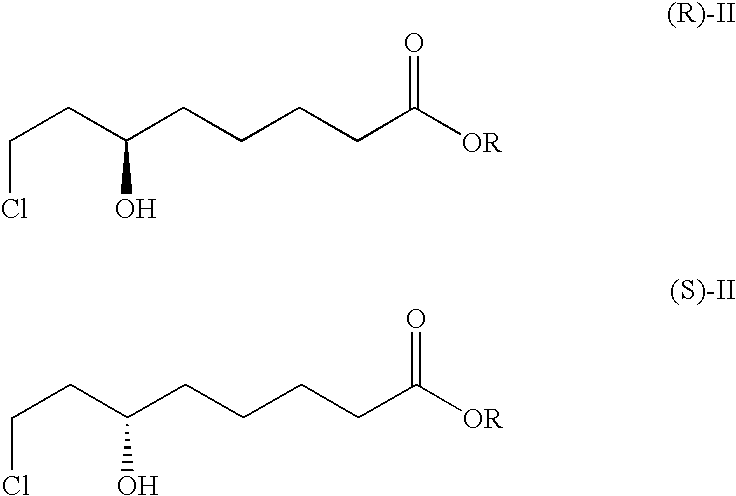Method for the enantioselective reduction of 8-chloro-6-oxo-octanoic acid alkyl esters
a technology of octanoic acid and alkyl esters, which is applied in the field of enantioselective reduction of 8chloro6oxooctanoic acid alkyl esters, can solve the problems of asymmetric synthesis processes that generally require costly and complicated starting compounds, and require costly cofactors, so as to promote selectivity, increase yield and enantioselectivity, and promote selectivity
- Summary
- Abstract
- Description
- Claims
- Application Information
AI Technical Summary
Benefits of technology
Problems solved by technology
Method used
Image
Examples
example 1
[0022] The strain Mucor racemosus (DSM 13775) is cultured on Sabouraud's agar at 24.degree. C. 100 ml of YPD nutrient solution (1% yeast extract, 2% peptone and 2% glucose) is inoculated with an inoculating loop and incubated for 3 days at 24.degree. C. on an orbital shaker (190 rpm). 10% of this preculture are transferred into 100 ml of SMG medium (20 g / l glucose, 3 g / l (NH.sub.4).sub.2SO.sub.4, 4 g / l KH.sub.2PO.sub.4, 0.5 g / l MgSO.sub.4, 0.2 g / l NaCl, 0.2 g / l yeast extract, 3 mg / l FeCl.sub.3.times.6 H.sub.2O, 3 mg / l CaCl.sub.2.times.2 H.sub.2O, 0.4 mg / l MnSO.sub.4.times.H.sub.2O, 0.5 mg / l ZnSO.sub.4.times.7 H.sub.2O and 0.05 mg CuSO.sub.4.times.5 H.sub.2O) and cultured for a further 3 days at 24.degree. C.
[0023] The resultant biomass is centrifuged off and transferred into 100 ml of buffered aqueous solution (50 mmol Na phosphate buffer, pH 6.5) comprising 5 g / l of glucose. 0.5 g of 8-chloro-6-oxo-octanoic acid methyl ester are dissolved in 2 ml of ethanol and added to the biotran...
example 2
[0024] The strain Geotrichum candidum (DSM 13776) is cultured on Sabouraud's agar at 24.degree. C. 100 ml of YPD nutrient solution (1% yeast extract, 2% peptone and 2% glucose) is inoculated with an inoculating loop and incubated for 3 days at 24.degree. C. on an orbital shaker (190 rpm). 10% of this preculture are transferred into 100 ml of SMG medium (20 g / l glucose, 3 g / l (NH.sub.4).sub.2SO.sub.4, 4 g / l KH.sub.2PO.sub.4, 0.5 g / l MgSO.sub.4, 0.2 g / l NaCl, 0.2 g / l yeast extract, 3 mg / l FeCl.sub.3.times.6 H.sub.2O, 3 mg / l CaCl.sub.2.times.2 H.sub.2O, 0.4 mg / l MnSO.sub.4.times.H.sub.2O, 0.5 mg / l ZnSO.sub.4.times.7 H.sub.2O and 0.05 mg CuSO.sub.4.times.5 H.sub.2O) and cultured for a further 3 days at 24.degree. C.
[0025] The resultant biomass is centrifuged off and transferred into 100 ml of buffered aqueous solution (50 mmol Na phosphate buffer, pH 6.5) comprising 5 g / l of glucose. 0.5 g of 8-chloro-6-oxo-octanoic acid methyl ester are dissolved in 2 ml of ethanol and added to the bio...
PUM
 Login to View More
Login to View More Abstract
Description
Claims
Application Information
 Login to View More
Login to View More - R&D
- Intellectual Property
- Life Sciences
- Materials
- Tech Scout
- Unparalleled Data Quality
- Higher Quality Content
- 60% Fewer Hallucinations
Browse by: Latest US Patents, China's latest patents, Technical Efficacy Thesaurus, Application Domain, Technology Topic, Popular Technical Reports.
© 2025 PatSnap. All rights reserved.Legal|Privacy policy|Modern Slavery Act Transparency Statement|Sitemap|About US| Contact US: help@patsnap.com



